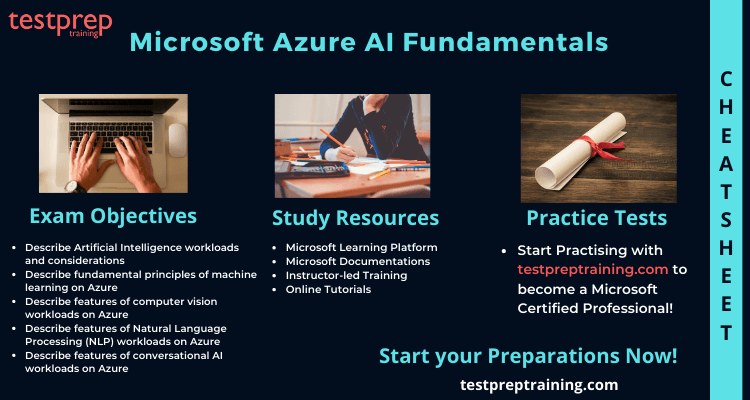Microsoft AI-900 is an exam that measures the knowledge and skills of individuals in the area of artificial intelligence (AI) and machine learning (ML) concepts, as well as the ability to identify use cases and tools that can be used to implement AI and ML solutions using Microsoft Azure services. The exam is intended for individuals who are new to the AI and ML field, and who want to demonstrate their foundational knowledge of these concepts and their ability to work with Azure AI services. The exam covers topics such as the principles of AI, machine learning, computer vision, natural language processing, and Azure AI services.
Microsoft AI-900 Exam Glossary
Here are some key terms and concepts that are commonly covered on the Microsoft AI-900 exam:
- Artificial Intelligence (AI) – The simulation of human intelligence processes by computer systems, including learning, reasoning, and self-correction.
- Machine Learning (ML) – A subset of AI that involves training models on large datasets to make predictions or classifications without being explicitly programmed.
- Deep Learning – A special type of machine learning that uses layered neural networks to study and sort data.
- Natural Language Processing (NLP) – The ability of computers to understand, interpret, and generate human language.
- Computer Vision – The ability of computers to analyze and interpret visual data, such as images and videos.
- Azure AI services – A suite of services and tools provided by Microsoft Azure for building and deploying AI and ML solutions, including Azure Machine Learning, Azure Cognitive Services, and more.
- Data Science – A multidisciplinary field that involves using statistical and computational methods to extract insights and knowledge from data.
- Understand Data preprocessing – The process of cleaning and preparing data before it can be used for analysis or modeling.
- Data labelling – The process of annotating data with labels or tags to enable supervised learning.
- Model evaluation – The process of assessing the accuracy and performance of machine learning models.
- Overfitting – In machine learning, there’s a frequent issue when a model is too complicated and closely follows the training data, leading to not-so-great performance on fresh data.
- Deployment – The process of deploying machine learning models to production environments or integrating them with other applications.
- Ethics and responsible AI – The importance of ethical considerations when developing and deploying AI solutions, such as transparency, fairness, and privacy.
- Explainable AI – The ability of AI systems to provide clear explanations of their decision-making processes and recommendations.
Microsoft AI-900 Study Guide
Here are some official Microsoft resources for the Microsoft AI-900 exam:
- Microsoft AI-900 Exam Page: https://docs.microsoft.com/en-us/learn/certifications/exams/ai-900
- Microsoft Learn AI-900 Exam Learning Path: https://docs.microsoft.com/en-us/learn/certifications/exams/ai-900
- AI-900 Exam Study Guide: https://query.prod.cms.rt.microsoft.com/cms/api/am/binary/RE4S5G5
- Learn AI-900 Exam Sample Questions: https://query.prod.cms.rt.microsoft.com/cms/api/am/binary/RE4SeWe
- AI-900 Exam Skills Measured: https://query.prod.cms.rt.microsoft.com/cms/api/am/binary/RE4S1G1
- Microsoft Certification Dashboard: https://www.microsoft.com/en-us/learning/dashboard.aspx
Note: Microsoft also offers paid courses and practice tests through the Microsoft Learn platform.
Microsoft AI-900 Exam Tips and Tricks
Here are some tips and tricks for the Microsoft AI-900 exam:
- Understand the exam objectives: Make sure you review the AI-900 Exam Skills Measured document provided by Microsoft. This document outlines the key topics that will be covered on the exam.
- Study the concepts: Focus on the core concepts of AI, machine learning, and data science. You should also be familiar with the Azure services that are used for AI and machine learning.
- Hands-on experience: Practice using Azure services for AI and machine learning. You can use the Microsoft Learn platform to access free training modules that provide hands-on experience.
- Use official Microsoft resources: Microsoft provides a variety of free resources for the AI-900 exam, including a study guide, sample questions, and reference material. Make sure to use these resources to prepare for the exam.
- Take practice tests: Take advantage of practice tests to gauge your knowledge and identify areas where you need to focus your studies.
- Manage your time: The exam has a time limit of 60 minutes. Make sure you manage your time effectively and don’t spend too much time on any single question.
Cheat Sheet | Microsoft AI-900
Professional certifications make you job-ready and provide a competitive edge. Preparing for a certification exam is just like planning to accomplish any significant goal. This Microsoft Azure AI-900 exam cheat sheet provided you with a quick summary of the exam and its resources. It is easy to digest and really helpful in your last-minute revisions.

Review the AI-900 Exam Topics
Begin by checking out the official website of Microsoft. It’s a wise choice as it’s the most reliable source for accurate information. The site contains everything you need to know about the Microsoft Azure AI-900 exam—exam patterns, modules, and study materials. Take the time to understand all the objectives and course areas. Allocate sufficient time to each topic to gain a deep understanding of the subject. This thorough preparation will strengthen your readiness for the exam.
The updated Microsoft AI-900 exam topics include:
Topic 1: Describe Artificial Intelligence workloads and considerations (15-20%)
1.1 Identify features of common AI workloads
- Identify features of content moderation and personalization workloads
- identify computer vision workloads (Microsoft Documentation: Applying content tags to images, Detect common objects in images, Detect popular brands in images)
- identifying natural language processing workloads (Microsoft Documentation: Choosing a natural language processing technology in Azure)
- identify knowledge mining workloads (Microsoft Documentation: Explore knowledge mining)
- Identify document intelligence workloads
- Identify features of generative AI workloads
1.2 Identify guiding principles for responsible AI
- describing the considerations for fairness in an AI solution (Microsoft Documentation: Model performance and fairness (preview))
- explaining the considerations for reliability and safety in an AI solution (Microsoft Documentation: Responsible and trusted AI)
- describing the considerations for privacy and security in an AI solution (Microsoft Documentation: Responsible AI)
- explaining the considerations for inclusiveness in an AI solution (Microsoft Documentation: Responsible and trusted AI)
- describing considerations for transparency in an AI solution (Microsoft Documentation: Identify guiding principles for responsible AI)
- describing considerations for accountability in an AI solution (Microsoft Documentation: Responsible and trusted AI, Identify guiding principles for responsible AI)
Topic 2: Describe fundamental principles of machine learning on Azure (20-25%)
2.1 Identify common machine learning techniques
- identifying regression machine learning scenarios (Microsoft Documentation: Linear Regression)
- identifying classification machine learning scenarios (Microsoft Documentation: Classification modules)
- identify clustering machine learning scenarios (Microsoft Documentation: Clustering modules)
- Identify features of deep learning techniques
2.2 Describe core machine learning concepts
- identifying features and labels in a dataset for machine learning (Microsoft Documentation: Create and explore Azure Machine Learning dataset with labels)
- explaining how training and validation datasets are used in machine learning (Microsoft Documentation: Configure training, validation, cross-validation and test data in automated machine learning)
2.3 Describe Azure Machine Learning capabilities
- Describe capabilities of Automated machine learning (Microsoft Documentation: Automated machine learning (AutoML))
- Describe data and compute services for data science and machine learning
- Describe model management and deployment capabilities in Azure Machine Learning
Topic 3: Describe features of computer vision workloads on Azure (15-20%)
3.1 Identify common types of computer vision solution:
- identifying features of image classification solutions (Microsoft Documentation: Train image classification models with MNIST data and scikit-learn)
- identify features of object detection solutions (Microsoft Documentation: Detect common objects in images)
- identifying features of optical character recognition solutions (Microsoft Documentation: Optical Character Recognition (OCR))
- identify features of facial detection and facial analysis solutions
3.2 Identify Azure tools and services for computer vision tasks
- Describe capabilities of the Azure AI Vision service
- Describe capabilities of the Azure AI Face detection service
Topic 4: Describe features of Natural Language Processing (NLP) workloads on Azure (15-20%)
4.1 Identify features of common NLP Workload Scenarios
- identifying features and uses for key phrase extraction (Microsoft Documentation: How to extract key phrases using Text Analytics)
- identify the features and uses for entity recognition (Microsoft Documentation: Entity Recognition cognitive skill)
- identifying features and uses for sentiment analysis (Microsoft Documentation: What is sentiment analysis and opinion mining)
- identifying features and uses for language modeling (Microsoft Documentation: language detection in Azure Cognitive Service for Language)
- identify the features and uses for speech recognition and synthesis (Microsoft Documentation: Get started with speech-to-text, Speech service)
- identifying features and uses for translation (Microsoft Documentation: Translator service)
4.2 Identify Azure tools and services for NLP workloads
- identifying capabilities of the Azure AI Language Service (Microsoft Documentation: Azure Cognitive Service for Language)
- identify the capabilities of the Azure AI Speech service (Microsoft Documentation: Speech service)
Topic 5: Describe features of generative AI workloads on Azure (15–20%)
5.1 Identify features of generative AI solutions
- Identify features of generative AI models
- Identify common scenarios for generative AI
- Identify responsible AI considerations for generative AI
5.2 Identify capabilities of Azure OpenAI Service
- Describe natural language generation capabilities of Azure OpenAI Service
- Describe code generation capabilities of Azure OpenAI Service
- Describe image generation capabilities of Azure OpenAI Service
Know your Study Resources
It’s really important to emphasize that the key to grasping every aspect is to find the correct learning materials. Let’s guide you on where to find these resources. This not only builds a solid foundation for qualification but also boosts your confidence among your peers.
Microsoft Learning Platform
Microsoft provides access to learning platforms with various resources that will help in exam preparation. However, make sure to go through the official website of Microsoft. For the AI-900 exam, it would be best to first go through the Microsoft official website to get authentic information about the exam. You can easily locate the AI-900 page where you can just go through all the necessary information about the AI-900 exam. Furthermore, Microsoft provided access to the Microsoft Docs AI-900 learning path as well as the Instructor-led training. These provide advantages to the candidates to understand the concepts more accurately and pass the exam. They are:
Microsoft Docs
Microsoft documentation is the source of knowledge that provides detailed information about the AI-900 exam concepts. Moreover, you also get to know the different scales of different Azure AI services. Microsoft Docs consists of modules that will help you gain a lot of knowledge about AI and the different services in a sequence.
Instructor-led Training
This Instructor-led training course provides the fundamentals concepts related to artificial intelligence (AI), and the services in Microsoft Azure for creating AI solutions. Yet, it’s essential to note that this course isn’t meant to turn students into professional data scientists or software developers. Instead, it aims to create an understanding of typical AI tasks and the capability to recognize Azure services for support. The Microsoft AI-900 training includes practical exercises from Learn modules, and candidates can use Learn’s content as a reference. This course suits those keen on discovering the possibilities of artificial intelligence solutions, though some familiarity with computer tech and the Internet is necessary.
Online Tutorials
Online Tutorials enhance your knowledge and provide in depth understanding about the exam concepts. Moreover, the Microsoft Azure AI-900 exam tutorials include information about the exam’s details and policies. So, studying with online tutorials will further solidify your preparation.
Practice Tests to self evaluate
Taking practice tests is crucial for effective preparation. These tests help you identify your strengths and weaknesses. Additionally, practicing improves your answering skills, saving you valuable time during the actual exam. It’s best to start doing AI-900 practice tests after finishing a whole topic, as it serves as a useful revision. Ensure you find reliable sources for the best practice experience. Start practicing Now!
Your best career opportunity is just a few tests away. Start preparing for the AI-900: Microsoft Azure AI Fundamentals exam !



